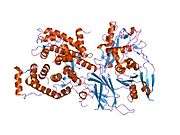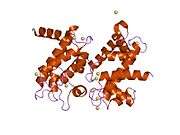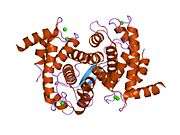CAPNS1
| CAPNS1 | |||||||||||||||||
|---|---|---|---|---|---|---|---|---|---|---|---|---|---|---|---|---|---|
 | |||||||||||||||||
| |||||||||||||||||
| Identifiers | |||||||||||||||||
| Aliases | CAPNS1, 30K, CALPAIN4, CANP, CANPS, CAPN4, CDPS, CSS1, calpain small subunit 1 | ||||||||||||||||
| External IDs | MGI: 88266 HomoloGene: 1327 GeneCards: CAPNS1 | ||||||||||||||||
| |||||||||||||||||
| Orthologs | |||||||||||||||||
| Species | Human | Mouse | |||||||||||||||
| Entrez | |||||||||||||||||
| Ensembl | |||||||||||||||||
| UniProt | |||||||||||||||||
| RefSeq (mRNA) | |||||||||||||||||
| RefSeq (protein) | |||||||||||||||||
| Location (UCSC) | Chr 19: 36.14 – 36.15 Mb | Chr 7: 30.19 – 30.2 Mb | |||||||||||||||
| PubMed search | [1] | [2] | |||||||||||||||
| Wikidata | |||||||||||||||||
| |||||||||||||||||
Calpain small subunit 1, also known as CAPN4, is a protein that in humans is encoded by the CAPNS1 gene.[3][4][5]
Calpains are a ubiquitous, well-conserved family of calcium-dependent, cysteine proteases. Calpain families have been implicated in neurodegenerative processes, as their activation can be triggered by calcium influx and oxidative stress. Calpain I and II are heterodimeric with distinct large subunits associated with common small subunits, all of which are encoded by different genes. Two transcript variants encoding the same protein have been identified for this gene.[5]
Functions
Myotonic dystrophy
This gene encodes a small subunit common to both calpain I and II and is associated with myotonic dystrophy.[5]
Biomarker
Elevated expression of Capn4 has been found to be associated with progression of various cancers such as hepatocellular and renal carcinoma. [6]
References
- ↑ "Human PubMed Reference:".
- ↑ "Mouse PubMed Reference:".
- ↑ Miyake S, Emori Y, Suzuki K (Jan 1987). "Gene organization of the small subunit of human calcium-activated neutral protease". Nucleic Acids Res. 14 (22): 8805–17. PMC 311912
 . PMID 3024120. doi:10.1093/nar/14.22.8805.
. PMID 3024120. doi:10.1093/nar/14.22.8805. - ↑ Ohno S, Emori Y, Suzuki K (Sep 1986). "Nucleotide sequence of a cDNA coding for the small subunit of human calcium-dependent protease". Nucleic Acids Res. 14 (13): 5559. PMC 311560
 . PMID 3016651.
. PMID 3016651. - 1 2 3 "Entrez Gene: CAPNS1 calpain, small subunit 1".
- ↑ Zhuang Q (Apr 2014). "Capn4 mRNA level is correlated with tumour progression and clinical outcome in clear cell renal cell carcinoma.". J Int Med Res. 42: 282–91. PMID 24514433. doi:10.1177/0300060513505524.
External links
- Human CAPNS1 genome location and CAPNS1 gene details page in the UCSC Genome Browser.
Further reading
- Suzuki K, Sorimachi H, Yoshizawa T, et al. (1996). "Calpain: novel family members, activation, and physiologic function". Biol. Chem. Hoppe-Seyler. 376 (9): 523–9. PMID 8561910.
- Tidball JG, Spencer MJ (2000). "Calpains and muscular dystrophies". Int. J. Biochem. Cell Biol. 32 (1): 1–5. PMID 10661889. doi:10.1016/S1357-2725(99)00095-3.
- Huang Y, Wang KK (2001). "The calpain family and human disease". Trends in molecular medicine. 7 (8): 355–62. PMID 11516996. doi:10.1016/S1471-4914(01)02049-4.
- Reverter D, Sorimachi H, Bode W (2001). "The structure of calcium-free human m-calpain: implications for calcium activation and function". Trends Cardiovasc. Med. 11 (6): 222–9. PMID 11673052. doi:10.1016/S1050-1738(01)00112-8.
- Banik NL, DeVries GH, Neuberger T, et al. (1991). "Calcium-activated neutral proteinase (CANP; calpain) activity in Schwann cells: immunofluorescence localization and compartmentation of mu- and mCANP". J. Neurosci. Res. 29 (3): 346–54. PMID 1656060. doi:10.1002/jnr.490290310.
- Ohno S, Minoshima S, Kudoh J, et al. (1990). "Four genes for the calpain family locate on four distinct human chromosomes". Cytogenet. Cell Genet. 53 (4): 225–9. PMID 2209092. doi:10.1159/000132937.
- Andersson B, Wentland MA, Ricafrente JY, et al. (1996). "A "double adaptor" method for improved shotgun library construction". Anal. Biochem. 236 (1): 107–13. PMID 8619474. doi:10.1006/abio.1996.0138.
- Zhang W, Lane RD, Mellgren RL (1996). "The major calpain isozymes are long-lived proteins. Design of an antisense strategy for calpain depletion in cultured cells". J. Biol. Chem. 271 (31): 18825–30. PMID 8702541. doi:10.1074/jbc.271.31.18825.
- Yu W, Andersson B, Worley KC, et al. (1997). "Large-scale concatenation cDNA sequencing". Genome Res. 7 (4): 353–8. PMC 139146
 . PMID 9110174. doi:10.1101/gr.7.4.353.
. PMID 9110174. doi:10.1101/gr.7.4.353. - Noguchi M, Sarin A, Aman MJ, et al. (1997). "Functional cleavage of the common cytokine receptor gamma chain (gammac) by calpain". Proc. Natl. Acad. Sci. U.S.A. 94 (21): 11534–9. PMC 23528
 . PMID 9326644. doi:10.1073/pnas.94.21.11534.
. PMID 9326644. doi:10.1073/pnas.94.21.11534. - Strobl S, Fernandez-Catalan C, Braun M, et al. (2000). "The crystal structure of calcium-free human m-calpain suggests an electrostatic switch mechanism for activation by calcium". Proc. Natl. Acad. Sci. U.S.A. 97 (2): 588–92. PMC 15374
 . PMID 10639123. doi:10.1073/pnas.97.2.588.
. PMID 10639123. doi:10.1073/pnas.97.2.588. - Masumoto H, Nakagawa K, Irie S, et al. (2000). "Crystallization and preliminary X-ray analysis of recombinant full-length human m-calpain". Acta Crystallogr. D. 56 (Pt 1): 73–5. PMID 10666632. doi:10.1107/S0907444999013748.
- Dias Neto E, Correa RG, Verjovski-Almeida S, et al. (2000). "Shotgun sequencing of the human transcriptome with ORF expressed sequence tags". Proc. Natl. Acad. Sci. U.S.A. 97 (7): 3491–6. PMC 16267
 . PMID 10737800. doi:10.1073/pnas.97.7.3491.
. PMID 10737800. doi:10.1073/pnas.97.7.3491. - Reverter D, Strobl S, Fernandez-Catalan C, et al. (2002). "Structural basis for possible calcium-induced activation mechanisms of calpains". Biol. Chem. 382 (5): 753–66. PMID 11517928. doi:10.1515/BC.2001.091.












